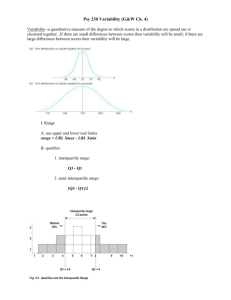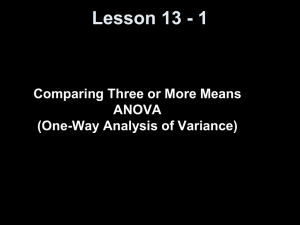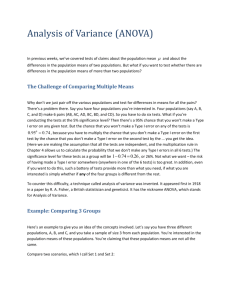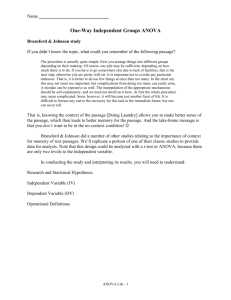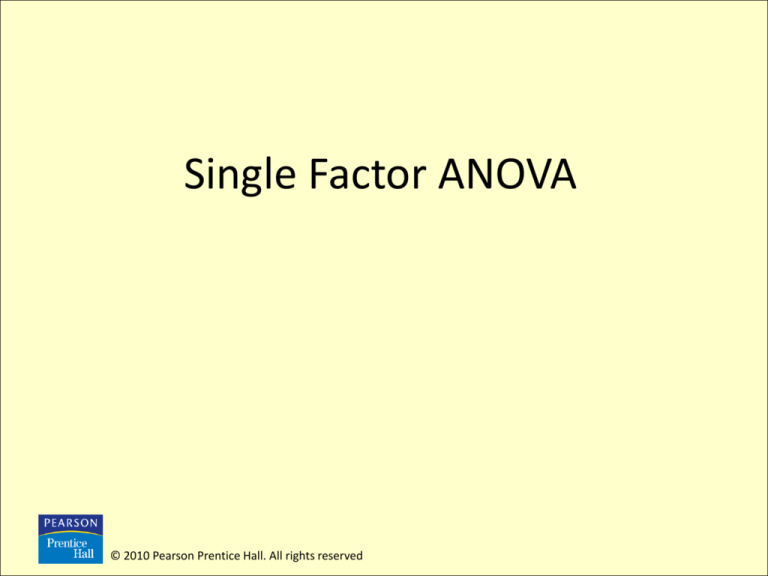
Single Factor ANOVA
© 2010 Pearson Prentice Hall. All rights reserved
Analysis of Variance (ANOVA) is an
inferential method used to test the equality of
three or more population means.
13-2
Requirements of a One-Way ANOVA Test
1. There are k simple random samples; one from
each of k populations.
2. The k samples are independent of each other;
that is, the subjects in one group cannot be
related in any way to subjects in a second
group.
3. The populations are normally distributed.
4. The populations have the same variance; that
is, each treatment group has the population
variance 2.
13-3
Verifying the Requirement of Equal
Population Variance
The one-way ANOVA procedures may be used
provided that the largest sample standard
deviation is no more than twice the smallest
sample standard deviation.
13-4
Parallel Example 1: Verifying the Requirements of ANOVA
The following data represent the weight (in grams) of
pennies minted at the Denver mint in 1990,1995, and
2000. Verify that the requirements in order to
perform a one-way ANOVA are satisfied.
13-5
1990
2.50
2.50
2.49
2.53
2.46
2.50
2.47
2.53
2.51
2.49
2.48
13-6
1995
2.52
2.54
2.50
2.48
2.52
2.50
2.49
2.53
2.48
2.55
2.49
2000
2.50
2.48
2.49
2.50
2.48
2.52
2.51
2.49
2.51
2.50
2.52
Solution
1. The 3 samples are simple random samples.
2. The samples were obtained independently.
3. Normal probability plots for the 3 years
follow. All of the plots are roughly linear so
the normality assumption is satisfied.
13-7
13-8
13-9
13-10
Descriptive Statistics
Variable
1990
1995
2000
Variable
1990
1995
2000
13-11
N
Mean Median TrMean StDev
11 2.4964 2.5000
2.4967 0.0220
11 2.5091 2.5000
2.5078 0.0243
11 2.5000 2.5000
2.5000 0.0141
Minimum
2.4600
2.4800
2.4800
Maximum
Q1
Q3
2.5300
2.4800 2.5100
2.5500
2.4900 2.5300
2.5200
2.4900 2.5100
SE Mean
0.0066
0.0073
0.0043
Solution
4. The sample standard deviations are
computed for each sample using Minitab
and shown on the following slide. The
largest standard deviation is not more than
twice the smallest standard deviation
(2*0.0141 =0.0282 > 0.02430) so the
requirement of equal population variances is
considered satisfied.
13-12
Alternative check for constant variance
Using Minitab we can use Levene’s test for
constant variability to perform a formal test
The result of Levene’s test shows that there is
insufficient evidence to support the claim of
nonconstant variability between the
populations of interest.
The basic idea in one-way ANOVA is to
determine if the sample data could come from
populations with the same mean, , or if the
sample evidence suggests that at least one
sample comes from a population whose mean
is different from the others. To make this
decision, we compare the variability among
the sample means to the variability within
each sample.
13-15
We call the variability among the sample means
the between-sample variability, and the
variability of each sample the within-sample
variability. If the between-sample variability is
large relative to the within-sample variability,
we have evidence to suggest that the samples
come from populations with different means.
13-16
ANOVA F-Test Statistic
The analysis of variance F-test statistic is given by
between - sample variability
F0
within - sample variability
mean square due to treatments
mean square due to error
MST
MSE
13-17
Computing the F-Test Statistic
Step 1: Compute the sample mean of the combined
data set by adding up all the observations and
dividing by the number of observations. Call
this value x .
Step 2: Find the sample mean for each sample (or
treatment). Let x1represent the sample mean
of sample 1, x2 represent the sample mean of
sample 2, and so on.
Step 3: Find the sample variance
for each sample (or
2
the sample
treatment). Let s1 represent
variance for sample 1, s22 represent the sample
for sample 2, and so on.
variance
13-18
Computing the F-Test Statistic
Step 4: Compute the sum of squares due to
treatments, SST, and the sum of squares due
to error, SSE.
Step 5: Divide each sum of squares by its
corresponding degrees of freedom (k-1 and nk, respectively) to obtain the mean squares
MST and MSE.
Step 6: Compute the F-test statistic:
mean square due to treatments
MST
F0
mean square due to error
MSE
13-19
Parallel Example 2: Computing the F-Test Statistic
Compute the F-test statistic for the penny data.
13-20
Solution
Step 1: Compute the overall mean.
2.50 2.50 2.50 2.52
x
2.5018
33
Step 2: Find the sample variance for each
treatment (year).
x1990 2.4964
13-21
x1995 2.5091
x2000 2.5
Solution
Step 3: Find the sample variance for each
treatment (year).
2.52 2.4964
2.48 2.4964
0.0005
111
2
s2000
0.0002
2
2
1990
s
2
s1995
0.0006
13-22
2
Solution
Step 4: Compute the sum of squares due to treatment,
SST, and the sum of squares due to error, SSE.
SST =11(2.4964-2.5018)2 + 11(2.5091-2.5018)2 +
11(2.5-2.5018)2 = 0.0009
SSE =(11-1)(0.0005) + (11-1)(0.0006) +
(11-1)(0.0002) = 0.013
13-23
Solution
Step 5: Compute the mean square due to treatment,
MST, and the mean square due to error, MSE.
SST 0.0009
MST =
0.0005
k 1
3 1
SSE 0.013
MSE =
0.0004
n k 33 3
13-24
Solution
Step 6: Compute the F-statistic.
MST 0.0005
F0
1.25
MSE 0.0004
13-25
Solution
ANOVA Table:
Source of Sum of Degrees of
Variation Squares Freedom
Treatment
Mean
Squares
0.0009
2
0.0005
Error
0.013
30
0.0004
Total
0.0139
32
13-26
F-Test
Statistic
1.25
Decision Rule in the One-Way ANOVA Test
If the P-value is less than the level of significance, ,
reject the null hypothesis.
13-27
For the pennies data a F-statistic of 1.25 results
in a P-value of 0.301.
Since the P-value exceeds the default level of
significance of 0.05 we will fail to reject H0.
Conclusion: We have insufficient evidence at
the 5% level of significance to support the
claim that the mean weight of pennies for at
least one of the years does not equal the
others.


